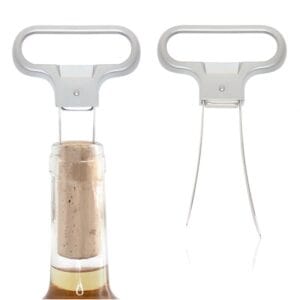Choosing the right wine rack design for your space requires a thoughtful approach, considering style, capacity, material, placement, and the balance between functionality and aesthetics. A well-chosen wine rack not only serves as a practical storage solution but also becomes a stylish design element that enhances your interior and elevates your wine experience. Whether you're a novice collector or a seasoned wine lover, the right choice depends on your personal preferences, available space, and how you want to display your wine collection.
What are the main styles in wine rack design?
The world of wine rack design offers a rich palette of styles, each with its own character and appearance. Minimalist design Characterized by clean lines, simple shapes, and the use of neutral colors, these wine racks fit perfectly in modern interiors where tranquility and space are paramount. They allow the bottles themselves to take center stage, without distracting from the design.
Modern wine racks take things a step further, experimenting with innovative materials like acrylic, brushed steel, or even sustainable bamboo. These designs often play with geometric shapes, creating a visually interesting statement in your space. They're ideal for those who want to showcase their wine collection as art.
Classic wine racks exude warmth and tradition, often crafted from dark woods like oak or walnut. These timeless designs fit perfectly in rustic or traditional interiors and add a sense of authenticity to your wine storage. They combine craftsmanship with functionality and often offer space for larger collections.
Industrial design has gained popularity in recent years, especially in loft-style spaces and modern apartments. These wine racks combine raw metal with wood or concrete, emphasizing functionality and a rugged look. Dutch design approach is characterized by combining these different styles with a focus on sustainability, local craftsmanship and innovative solutions that fit in with Dutch living culture.
How do you determine the right capacity for your wine rack?
Determining the right capacity for your wine rack starts with an honest assessment of your current collection and future ambitions. Don't just count your current bottles; also consider your purchasing habits. Do you buy a few bottles every week, or do you invest in larger quantities periodically during wine tastings or seasonal purchases?
A practical rule of thumb is to choose a wine rack with at least 30% more capacity than your current collection. This provides room for growth and prevents you from having to reinvest in the near future. For Dutch quality wines, which are often produced in smaller quantities, it's wise to consider seasonal availability.
| Type of collector | Recommended capacity | Ideal wine rack size |
|---|---|---|
| Beginning enthusiast | 12-24 bottles | Compact table model or wall rack |
| Regular drinker | 24-50 bottles | Medium-sized floor model |
| Serious collector | 50-100 bottles | Large cabinet or modular system |
| Wine connoisseur | 100+ bottles | Wine cabinet or cellar equipment |
Also consider the diversity of your collection. Dutch wines often come in a variety of bottle sizes, from elegant Rieslings to wider Burgundy bottles for complex orange wines. Make sure your wine rack is flexible enough to accommodate different bottle types.
Which materials suit your space best?
The material you choose for your wine rack significantly influences both its appearance and functionality. Wood remains a popular choice for its natural warmth and versatility. Oak offers durability and a timeless look, while lighter woods like birch or ash add a modern, Scandinavian touch to your interior.
Metal wine racks, especially in black or brushed steel, are a perfect fit for modern and industrial interiors. They often have a sleeker design and take up less visual space. For a luxurious look, consider brass or copper accents that will age beautifully and develop character.
Glass and acrylic offer transparency and lightness, ideal for smaller spaces where you don't want to place heavy furniture. These materials let light through and create a floating effect for your wine collection. Combinations of materials, such as wood with metal frames or glass with wooden accents, offer the best of both worlds.
The choice of materials plays a role sustainability An increasingly important role. Choose FSC-certified wood, recycled metal, or locally produced materials. Dutch artisans often work with reclaimed materials or wood from sustainably managed forests, which perfectly aligns with the growing demand for environmentally friendly design solutions.
Where do you place a wine rack design for optimal use?
The location of your wine rack determines not only its ease of use but also the quality of your wine storage. The kitchen seems like a logical place, but be mindful of temperature fluctuations caused by cooking and the proximity of heat sources like ovens or dishwashers. A wine rack in the kitchen works best when placed away from direct heat sources.
The living room offers excellent opportunities to integrate your wine rack as a design element. Place it as a focal point against an accent wall or use a freestanding model as a room divider. Just make sure the rack isn't in direct sunlight, as this can be harmful to the wine.
A cellar or utility room offers ideal conditions for wine storage: consistently cool temperatures, low light, and minimal vibration. Here, you can opt for larger, more functional racks without worrying about aesthetic integration into your living space.
If you're looking to create a dedicated wine storage space, consider a corner of the dining room or a niche under the stairs. These locations often offer the perfect combination of accessibility, temperature stability, and visual impact. Always consider factors such as humidity, temperature (ideally between 12-18°C), and vibration-free conditions for optimal wine storage.
How do you combine functionality with aesthetics in wine rack design?
The art of choosing the perfect wine rack lies in finding the balance between practical storage and visual appeal. A functional wine rack should keep your bottles safe, provide easy access, and display them at the right angle (ideally, slightly tilted to keep the cork moist). At the same time, you want it to be a valuable design element in your interior.
Modular systems offer the perfect solution for those seeking flexibility. These shelving units can grow with your collection and adapt to changing spaces. They combine functionality with a sleek, modern design that fits into any interior.
Think of your wine rack as an art installation that reflects your passion for wine. Use lighting to accent your collection, for example, with built-in LED strips that illuminate the bottles from below. This not only creates a dramatic effect but also makes it easier to select the right bottle in the evening.
Integrating wine racks as artistic elements requires creativity. Think asymmetrical designs that catch the eye, or racks that form geometric patterns when filled with bottles. This approach transforms functional storage into a visual statement that sparks conversation and perfectly unites your love of wine and design.
Choosing the right wine rack design is a personal journey, harmonizing your unique style, space, and wine collection. Whether you opt for minimalist design, classic elegance, or industrial robustness, the most important thing is that your wine rack complements your lifestyle and the way you enjoy wine. By paying attention to capacity, materials, placement, and the balance between function and form, you create not only a practical storage solution but also a design element that enhances your interior and underscores your passion for wine. For those who want to learn more about the wines you'll be storing in your new wine rack, Dutch wine tasting an excellent way to deepen your knowledge.



